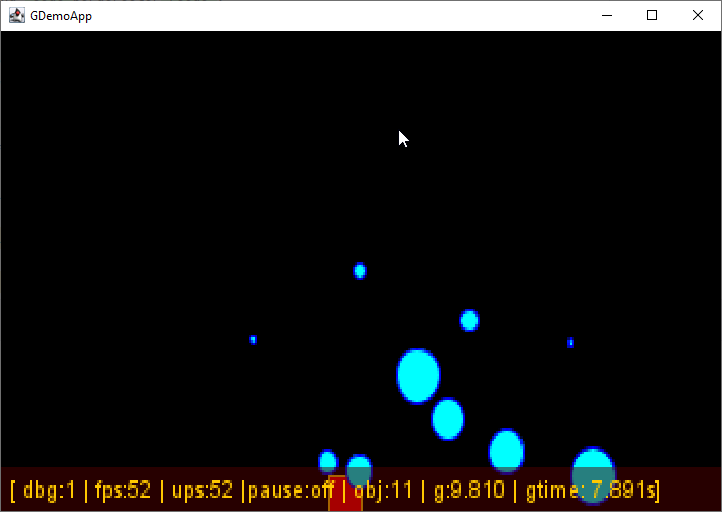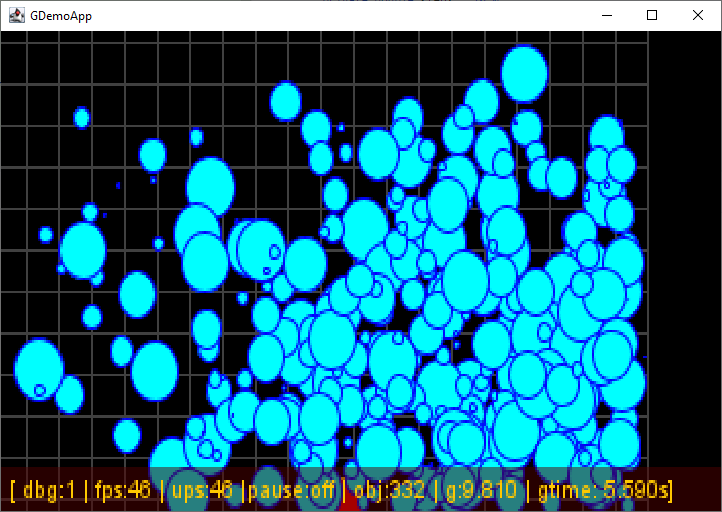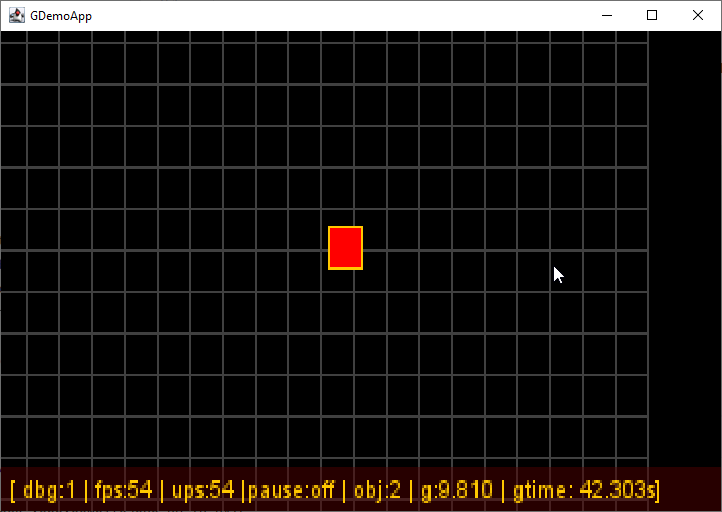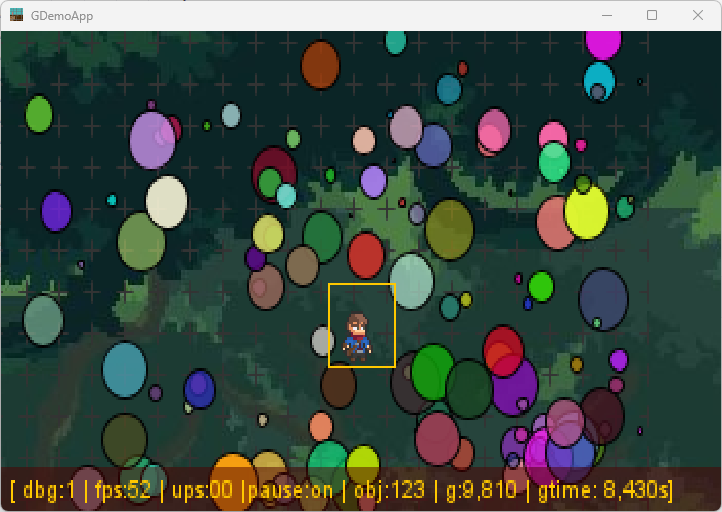game101
Upgrade with GameObject and Plugin
Goals
As we are going to enforce the entity model, we need to specialize the rendering pipeline to not let it become a Monster Gaz plant and an unmaintainable class.
We also want to propose some specialized Entity to implement new graphical elements but also new behaviors and usages.
The new coming GameObject could be
- a POINT,
- a LINE,
- a RECTANGLE,
- an ELLIPSE
- or an IMAGE.
Let’s move to some interesting changes, opening to more features and fancy things.
Proposed evolution
To satisfy those goals, I need to move out from Entity to let it support the internals of our Renderer and entity’s
identification or basic attributes like position.
But every thing else will move to a new class named GameObject.
GameObject class
The GameObject class extending Entity intends to provide new attributes to offers new draw capabilities.
- a
typefield to propose multiple nature of object with a new enumerationObjectType, proposing the following possible type values- POINT,
- LINE,
- RECTANGLE,
- ELLIPSE
- and IMAGE,
- an
imageattribute to store the image to be displayed in cas oftype=IMAGE. - the
directionis added now but will be used at rendering time to draw the image in the right direction (LEFT<0 or RIGHT>1).
public class GameObject extends Entity<GameObject> {
//...
public ObjectType type;
public double direction;
public BufferedImage image;
//...
}
According to the new type attribute, the updateBox() method must be adapted to the new possibilities:
public class GameObject extends Entity<GameObject> {
//...
public void updateBox() {
switch (type) {
case RECTANGLE, IMAGE, LINE, POINT -> {
this.box = new Rectangle2D.Double(x, y, width, height);
}
case ELLIPSE -> {
this.box = new Ellipse2D.Double(x, y, width, height);
}
default -> {
// nothing to do !
}
}
}
//...
}
The type will be used by the Renderer plugin DrawHelperPlugin implementation to draw the GameObject in the right
way.
And to satisfy debug purpose with new type attribute values :
public class GameObject extends Entity<GameObject> {
//...
public List<String> getDebugInfo() {
//...
infos.add(String.format("(1)id:%04d", this.id));
infos.add(String.format("(1)name:%s", this.name));
infos.add(String.format("(2)type:%s", type.toString()));
//...
return infos;
}
//...
}
Entity update
To organize the rendering pipeline, we add 2 new attributes to the Entity to group by layer, and define some rendering priority in one layer:
public class GameObject extends Entity<GameObject> {
//...
private int layer;
private int priority;
//...
}
The DrawHelperPlugin
Heart of our plugin implementation, this class defines the draw helper API: according to a specific object nature, its class, the plugin must provide the right way to draw it.
interface DrawHelperPlugin<T extends Entity> {
void draw(Renderer r, Graphics2D g, T object);
}
The draw() method must remain very simple process on only focus on drawing. no update or complex branch switching. You
certainly noticed that the 3 parameters:
Renderer rto get a reference to other possible contextual information in the Renderer,Graphics2D gthe Java 2D graphics API to draw things,T objectthe instance of the object to be drawn.
The Renderer adaptation
The New Renderer drawEntity() method is now very simple, delegating draw operations to the right plugin, identified
it by the e Entity class instance nature::
public class Renderer {
//...
private void drawEntity(Graphics2D g, Entity<?> e) {
if (plugins.containsKey(e.getClass())) {
DrawHelperPlugin<? extends Entity<?>> dhp = plugins.get(e.getClass());
dhp.draw(this, g, e);
}
}
//...
}
The GameObjectDrawHelperPlugin
Let’s hava a real example of a DrawHelperPlugin implementation for the new GameObject class:
public class GameObjectDrawHelperPlugin implements DrawHelperPlugin<GameObject> {
@Override
public Class<GameObject> getEntityType() {
return GameObject.class;
}
@Override
public void draw(Renderer r, Graphics2D g, Entity<?> entity) {
GameObject go = (GameObject) entity;
switch (go.type) {
//...
}
}
}
We need to define a clear process to draw each of the GameObject nature object:
public class GameObjectDrawHelperPlugin implements DrawHelperPlugin<GameObject> {
//...
@Override
public void draw(Renderer r, Graphics2D g, Entity<?> entity) {
GameObject go = (GameObject) entity;
switch (go.type) {
case POINT, RECTANGLE, ELLIPSE -> {
if (Optional.ofNullable(go.fillColor).isPresent()) {
g.setColor(go.fillColor);
g.fill(go.box);
}
if (Optional.ofNullable(go.borderColor).isPresent()) {
g.setColor(go.borderColor);
g.draw(go.box);
}
}
//...
}
}
}
- while drawing a LINE will delegate it to the drawLine Graphics2D API,
public class GameObjectDrawHelperPlugin implements DrawHelperPlugin<GameObject> {
//...
@Override
public void draw(Renderer r, Graphics2D g, Entity<?> entity) {
GameObject go = (GameObject) entity;
switch (go.type) {
//...
case LINE -> {
if (Optional.ofNullable(go.borderColor).isPresent()) {
g.setColor(go.borderColor);
g.drawLine((int) go.x, (int) go.y,
(int) (go.x + go.width), (int) (go.y + go.height));
}
}
}
//...
}
}
- and the IMAGE will call the drawImage Graphics2D API to draw the image with the right direction:
NOTE You certainly noticed that the image rendering use the direction attribute to define the drawing direction of the image: LEFT is for
direction<0, RIGHT fordirection>0.
public class GameObjectDrawHelperPlugin implements DrawHelperPlugin<GameObject> {
//...
@Override
public void draw(Renderer r, Graphics2D g, Entity<?> entity) {
GameObject go = (GameObject) entity;
switch (go.type) {
//...
case IMAGE -> {
if (go.direction > 0) {
g.drawImage(go.image,
(int) go.x, (int) go.y,
null);
} else {
g.drawImage(go.image,
(int) (go.x + go.width), (int) go.y,
(int) -go.width, (int) go.height,
null);
}
}
}
}
}
The App adaptation.
Now the App class must provide GameObject and no more Entity in the create method:
public class App {
//...
public void create() {
//...
// (1)
var player = (GameObject) new GameObject("player")
// (2)
.setType(ObjectType.RECTANGLE)
.setFillColor(Color.RED)
.setBorderColor(new Color(0.3f, 0.0f, 0.0f))
.setSize(16.0, 16.0)
.setPosition((screenWidth - 32) * 0.5, (screenHeight - 32) * 0.5)
.setSpeed(0.0, 0.0)
.setAcceleration(0.0, 0.0)
.setMass(80.0)
.setDebug(1)
.setMaterial(Material.STEEL)
// (3)
.setLayer(1)
// (4)
.setPriority(1);
entityMgr.add(player);
//...
}
//...
}
You can now see the setting of the new GameObject:
- (1) instantiate a
GameObjectinstead of anEntity, - (2) set its
ObjectType, - (3) define its rendering
layer, - (4) set the rendering
priorityin its layer.
Executing our new Plugin architecture will show the following window:

Adding Interaction
To add more fun and test capabilities, I want the App implmentation offers the opportunity to manage the number of Ball objects on the play area.
| Key | Action |
|---|---|
| PAGEUP | Add 10 new Balls on the play Area |
| PAGEDOWN | Remove 10 Balls from the play Area |
| DELETE | Remove all Balls from the play Area |
So in the App class code:
public class App implements Game {
//...
public void input(Game g) {
//...
// Managing Balls
if (inputHandler.getKey(KeyEvent.VK_PAGE_UP)) {
// maximize number of managed entities.
if (getEntityManager().getEntities().size() < 2000) {
addNewBalls("ball_#", 10);
}
}
if (inputHandler.getKey(KeyEvent.VK_PAGE_DOWN)) {
removeNbObjectByNameFilter("ball_", 10);
}
if (inputHandler.getKey(KeyEvent.VK_DELETE)) {
removeAllObjectByNameFilter("ball_");
}
}
//...
}
And the required corresponding methods:
public class App implements Game {
//...
private void removeNbObjectByNameFilter(String objectName, int nb) {
List<Entity<?>> toBeRemoved = new ArrayList<>();
int count = 0;
for (Entity<?> e : getEntityManager().getEntities()) {
if (e.getName().contains(objectName)) {
toBeRemoved.add(e);
count++;
if (count > nb) {
break;
}
}
}
toBeRemoved.forEach(e -> {
getEntityManager().getEntityMap().remove(e.getName());
});
}
// (1)
private void addNewBalls(String objectName, int nb) {
int screenWidth = (int) config.get(ConfigAttribute.SCREEN_WIDTH);
int screenHeight = (int) config.get(ConfigAttribute.SCREEN_HEIGHT);
createBlueBalls(objectName, nb,
24.0,
screenWidth,
screenHeight,
Color.CYAN,
Color.BLUE);
}
// (2)
private void removeAllObjectByNameFilter(String objectName) {
List<Entity<?>> toBeRemoved = new ArrayList<>();
for (Entity<?> e : getEntityManager().getEntities()) {
if (e.getName().contains(objectName)) {
toBeRemoved.add(e);
}
}
toBeRemoved.forEach(e -> {
getEntityManager().getEntityMap().remove(e.getName());
});
}
//...
}
- Adding balls

- Removing all balls

Debugging Usage
Ok, we now understand how to specialize the rendering process for dedicated object. Let’s implement a second
new GameObject variation with a visual GridObject which purpose is only using it at development and debugging time.
The GridObject principle is to draw a simple grid with a defined size at the top background of our play area, to materialize this area and its size.
the GridObject
The GridObject class is a very simple one adding some new attributes to the GameObject stepX and stepY:
public class GridObject extends GameObject {
private double stepX = 16.0;
private double stepY = 16.0;
public GridObject(String name) {
super(name);
}
public GridObject setStepSize(double sx, double sy) {
this.stepX = sx;
this.stepY = sy;
return this;
}
//... setters and getters
}
We also implement the mandatory constructor and a specific setter for define easily the step size on X and Y axis.
The GridObjectDrawHelperPlugin
Now we add this new GridObject, we need to specialize the Renderer with a dedicated draw helper for this object nature.
public class GridObjectDrawHelperPlugin implements DrawHelperPlugin<GridObject> {
// (1)
@Override
public Class<?> getEntityType() {
return GridObject.class;
}
// (2)
@Override
public void draw(Renderer r, Graphics2D g, Entity e) {
GridObject go = (GridObject) e;
g.setColor(go.borderColor);
for (double x = 0; x < go.width; x += go.getStepX()) {
g.drawRect((int) x, 0, (int) go.getStepX(), (int) go.height);
}
for (double y = 0; y < go.height; y += go.getStepY()) {
g.drawRect((int) 0, (int) y, (int) go.width, (int) go.getStepY());
}
}
}
- we define the class on which this plugin must be used for,
- the
draw()method is a very simple one, drawing rectangle based on aGridObjectwidthandheightand thestepXandstepYsize with 2 for loops.
We now add this enw plugin to the Renderer:
public class Renderer {
public Renderer(Game g) {
//...
addPlugin(new GameObjectDrawHelperPlugin());
addPlugin(new GridObjectDrawHelperPlugin());
}
}
And in the App class, a Game interface implementation :
public class App implements Game {
public void create() {
//...
// Add a background GridObject as re visual reference
entityMgr.add(
new GridObject("grid")
.setStepSize(16.0, 16.0)
.setSize(
physicEngine.getWorld().getPlayArea().getWidth(),
physicEngine.getWorld().getPlayArea().getHeight())
.setBorderColor(Color.DARK_GRAY)
.setLayer(-1));
}
}
Global enhancement
We will add more colors to the rendering and add some images to the scene:
Ball creation
In the createBall method, let’s add some color and radius randomness :
class App implements Game {
//...
private void createBlueBalls(String ballNamePrefix,
int nbBall,
double ballRadius,
int width, int height,
Color fillColor, Color borderColor) {
for (int i = 0; i < nbBall; i++) {
// randomize the radius with a max to ballRadius.
double radius = Math.random() * ballRadius;
// create the ball with random color.
createBall(ballNamePrefix,
width, height,
(fillColor == null
? RandomColor.get(
0.0f, 0.0f, 0.0f, 0.5f,
1.0f, 1.0f, 1.0f, 1.0f)
: fillColor),
borderColor,
radius);
}
}
//...
}
Add a background image
As we need some image resources, we are going to use a new Game#loadResources()
interface to let the main GameLoop require the resources loading before create().
public interface Game {
//...
default void loadResources() {
}
//...
default void loop() {
//...
loadResources();
create();
while (!isExitRequested()) {
//...
}
}
}
And then in the App class, the corresponding implementation:
class App implements Game {
//...
@Override
public void loadResources() {
imageBackground = loadImage("/images/backgrounds/forest.jpg");
imagePlayer = loadImage("/images/sprites01.png");
}
// loading an Image resource from a path file.
private BufferedImage loadImage(String pathToImage) {
try {
return ImageIO.read(this.getClass().getResourceAsStream(pathToImage));
} catch (IOException e) {
logger.severe("Unable to read image resource from " + pathToImage);
}
return null;
}
//...
public void create() {
//...
var background = (GameObject) new GameObject("background")
.setImage(imageBackground)
.setLayer(1)
.setPriority(2);
entityMgr.add(background);
// Create the main player entity.
BufferedImage playerFrame1 = imagePlayer.getSubimage(0, 0, 32, 32);
var player = (GameObject) new GameObject("player")
.setImage(playerFrame1)
.setPosition((screenWidth - 32) * 0.5, (screenHeight - 32) * 0.5)
.setSpeed(0.0, 0.0)
.setAcceleration(0.0, 0.0)
.setMass(80.0)
.setDebug(1)
.setMaterial(Material.STEEL)
.setLayer(10)
.setPriority(1);
entityMgr.add(player);
//...
}
}
Then, executing the new enhanced App class :
gradle run
You must see the following animated window with :
- a background
GameObjectdisplaying an image, - a main
GameObjectthat is an image, - and a bunch of multicolor
GameObjects acting as ball:

Conclusion
Finally, executing our new Renderer implementation is able to satisfy any new need without change the core Renderer draw processing, and take benefits from all future GameObject descendants.
You can notice that the corresponding code will be found on the GitHub repository Game101 :
- on the create-gameobject-and-plugin
tag for the
GameObjectandRendererplugin architecture, - at the create-grid-object tag for the
new
GridObjectimplementation, used for debug purpose (mainly).
That’s All Folk !
McGivrer.